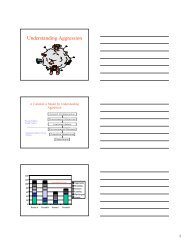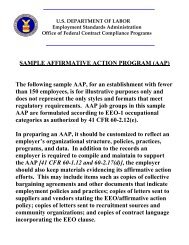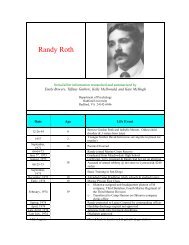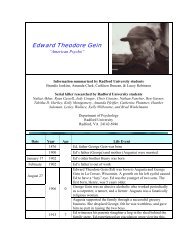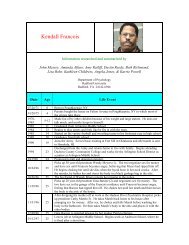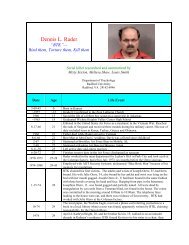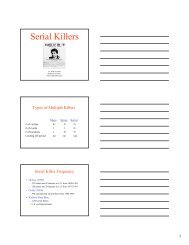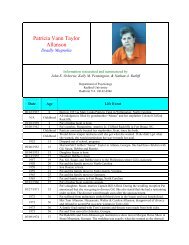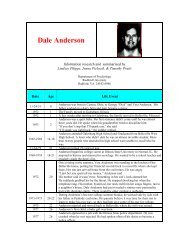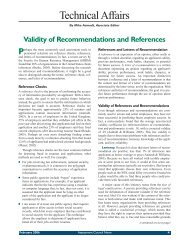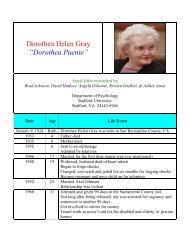The case against unstructured interviews - Dr. Mike Aamodt
The case against unstructured interviews - Dr. Mike Aamodt
The case against unstructured interviews - Dr. Mike Aamodt
You also want an ePaper? Increase the reach of your titles
YUMPU automatically turns print PDFs into web optimized ePapers that Google loves.
August 2005<br />
Technical Affairs<br />
By <strong>Mike</strong> <strong>Aamodt</strong>, Associate Editor<br />
<strong>The</strong> Case Against Unstructured Employment<br />
Interviews<br />
Although structured <strong>interviews</strong> were covered in a previous<br />
Technical Affairs Column (February 2001), it<br />
seems like a good idea to review the differences between<br />
structured and <strong>unstructured</strong> <strong>interviews</strong>. As most readers<br />
will agree, <strong>interviews</strong> are the most commonly used method<br />
to select employees. What readers may not agree on is the<br />
best way in which <strong>interviews</strong> should be conducted and the<br />
relative merits of different interview formats.<br />
Interviews are based on the assumption that a manager<br />
or human resource professional can ask an applicant questions,<br />
listen to the answers and the paralanguage associated<br />
with the answers (e.g., tone, speed, volume), observe the<br />
applicant’s nonverbal cues and appearance, make judgments<br />
about the applicant’s knowledge, skills, abilities,<br />
personality, interests, and values, and then logically combine<br />
this information to predict the applicant’s future performance,<br />
tenure, and person-organization fit. Though this<br />
practice sounds good in theory, in reality, traditional <strong>interviews</strong><br />
do not do a good job of predicting anything.<br />
Types of Interviews<br />
Perhaps a good place to start a discussion on <strong>interviews</strong> is<br />
to define the various types of <strong>interviews</strong>. Interviews vary<br />
on three main factors: structure, style, and medium.<br />
Structure<br />
<strong>The</strong> structure of an interview is determined by the source<br />
of the questions, extent to which all applicants are asked<br />
the same questions, and the structure of the system used to<br />
score answers. A structured interview is one in which (1)<br />
the source of the questions is a job analysis (job-related<br />
questions), (2) all applicants are asked the same questions,<br />
and (3) there is a standardized scoring key to evaluate each<br />
answer. An <strong>unstructured</strong> (or traditional) interview is one in<br />
which interviewers are free to ask anything they want (e.g.,<br />
Where do you want to be in five years? What was the last<br />
book you read?), are not required to have consistency in<br />
what they ask of each applicant, and points assigned to an<br />
answer are at the discretion of the interviewer. Because<br />
<strong>interviews</strong> vary in their structure, rather than calling <strong>interviews</strong><br />
structured or <strong>unstructured</strong>, it might make more sense<br />
to use terms such as highly structured (all 3 criteria are<br />
met), moderately structured (2 criteria are met), slightly<br />
structured (1 criterion met), and <strong>unstructured</strong> (none of the<br />
3 criteria are met). <strong>The</strong> research is clear that highly structured<br />
<strong>interviews</strong> are more reliable and valid than <strong>interviews</strong><br />
with less structure (Huffcutt & Arthur, 1994).<br />
A source of confusion regarding interview structure is<br />
the tendency to call structured <strong>interviews</strong>, behavioral <strong>interviews</strong>.<br />
<strong>The</strong> behavioral term actually relates to the type of<br />
question rather than the interview itself. Regardless of the<br />
structure of the interview, <strong>interviews</strong> contain six types of<br />
questions: clarifiers, disqualifiers, skill-level determiners,<br />
past-focused (behavioral), future-focused (situational), and<br />
organizational fit.<br />
Clarifiers allow the interviewer to clarify résumé, cover<br />
letter, and application information, fill in gaps, and obtain<br />
necessary information. Because each applicant’s résumé<br />
and cover letter are unique, specific clarifiers are not standard<br />
across applicants. For example, an interviewer may<br />
need to ask one applicant to explain what she won the<br />
McArthur Award for and another applicant what she was<br />
doing during a two-year gap between jobs.<br />
Disqualifiers are questions that must be answered a particular<br />
way or the applicant is disqualified. For example, if<br />
a job requires that employees work on weekends, a disqualifier<br />
might be “Are you available to work on weekends?”<br />
If the answer is “no,” the applicant will not get the<br />
job.<br />
Skill level determiners tap an interviewee’s level of<br />
expertise. For example, if an applicant says she is proficient<br />
in Microsoft Word, an interviewer might ask some<br />
questions about the word processing program. If an applicant<br />
claims to be fluent in Spanish, the interviewer might<br />
want to ask her a few questions in Spanish.<br />
Future-focused questions, also called situational questions,<br />
ask an applicant what she would do in a particular<br />
situation.<br />
Past-focused questions, commonly referred to as behavioral<br />
questions or patterned behavior description <strong>interviews</strong>,<br />
differ from situational interview questions by focusing<br />
on previous behavior rather than future intended<br />
behavior. That is, applicants are asked to provide specific<br />
examples of how they demonstrated job-related skills in<br />
previous jobs.<br />
(continued on next page)<br />
Assessment Council News 8
Technical Affairs continued<br />
Rather than trying to predict future performance, organizational-fit<br />
questions tap the extent to which an applicant<br />
will fit into the culture of an organization or with the leadership<br />
style of a particular supervisor. For example, some<br />
organizations are very policy-oriented whereas others<br />
encourage employees to use their initiative. Some supervisors<br />
are very task-oriented whereas others are more person-oriented.<br />
<strong>The</strong> idea behind organizational-fit questions<br />
is to make sure that the applicant’s personality and goals<br />
are consistent with those of the organization.<br />
Style<br />
<strong>The</strong> style of an interview is determined by the number of<br />
interviewees and number of interviewers. One-on-one<br />
<strong>interviews</strong> involve one interviewer interviewing one applicant.<br />
Serial <strong>interviews</strong> involve a series of single <strong>interviews</strong>.<br />
For example, the HR manger might interview an applicant<br />
at 9:00 a.m., the department supervisor <strong>interviews</strong> the<br />
applicant at 10:00 a.m., and the vice-president <strong>interviews</strong><br />
the applicant at 11:00 a.m. Return <strong>interviews</strong> are similar to<br />
serial <strong>interviews</strong> with the difference being a passing of<br />
time between the first and subsequent interview. For example,<br />
an applicant might be interviewed by the HR manager<br />
and then brought back a week later to interview with the<br />
vice-president. Panel <strong>interviews</strong> have multiple interviewers<br />
August 2005<br />
asking questions and evaluating answers of the same applicant<br />
at the same time, and group <strong>interviews</strong> have multiple<br />
applicants answering questions during the same interview.<br />
Of course, one could put together several combinations<br />
such as a serial-panel-group interview, but life is too short<br />
for such nonsense.<br />
Medium<br />
Interviews also differ on the extent to which they are done<br />
in person. In face-to-face <strong>interviews</strong>, both the interviewer<br />
and the applicant are in the same room. Face-to-face <strong>interviews</strong><br />
provide a personal setting and allow the participants<br />
to use both visual and vocal cues to evaluate information.<br />
Telephone <strong>interviews</strong> are often used to screen applicants<br />
but do not allow the use of visual cues (not always a bad<br />
thing).<br />
Videoconference <strong>interviews</strong> are conducted at remote<br />
sites. <strong>The</strong> applicant and the interviewer can hear and see<br />
each other but the setting is not as personal nor is the<br />
image and vocal quality of the interview as sharp as in<br />
face-to-face <strong>interviews</strong>. Written <strong>interviews</strong> involve the<br />
applicant answering a series of written questions and then<br />
sending the answers back through regular mail or through<br />
email.<br />
(continued on next page)<br />
Dennis A. Joiner & Associates<br />
DENNIS A. JOINER & ASSOCIATES<br />
Specialists in Supervisory and Management Assessment Since 1977<br />
Why Situational Judgment Tests (SJT) have become so popular:<br />
• Low-cost approach for assessing supervisory and managerial competencies<br />
• Easily administered to either large or small candidate groups<br />
• No reading list or candidate study time required (quicker eligible list)<br />
• Require no human ratings and no hand scoring (machine/computer scored)<br />
• Appropriate for virtually all supervisory and management job classifications<br />
• Result in positive candidate feedback and candidate acceptance<br />
• Can be custom keyed to the culture and requirements of your organization<br />
• Low or no adverse impact as compared to other types of written tests<br />
Tests (SJTs) now available for First Level Supervisor through Department Director (multiple versions)<br />
Special versions available for all promotional ranks of Law Enforcement & Fire/Emergency Services<br />
For a price list, more information or to order preview copies contact:<br />
DENNIS A. JOINER & ASSOCIATES<br />
4975 Daru Way, Fair Oaks, CA 95628<br />
Phone: (916) 967-7795<br />
Toll free: (877) 623-7432<br />
E-mail: joinerda@pacbell.net<br />
Assessment Council News 9
Technical Affairs continued<br />
Problems with Unstructured Interviews<br />
As mentioned previously, research is clear that highly<br />
structured <strong>interviews</strong> demonstrate higher levels of criterion<br />
validity than <strong>unstructured</strong> <strong>interviews</strong> (Huffcutt &<br />
Arthur, 1994; McDaniel, Whetzel, Schmidt, & Maurer,<br />
1994). <strong>The</strong>re are many reasons why <strong>unstructured</strong> <strong>interviews</strong><br />
do not do a good job of predicting future performance.<br />
Unstructured Interviews Lack Content Validity<br />
By definition, <strong>unstructured</strong> <strong>interviews</strong> are not based on a<br />
job analysis, and thus many of the questions asked are not<br />
job-related. Perhaps the best evidence of this is to look at<br />
any of the popular books that give advice on how to answer<br />
common interview questions. When interviewers ask such<br />
questions as, Where do you want to be in five years?, What<br />
was your favorite subject in school?, and What did you like<br />
least about your previous supervisor?, it is not surprising<br />
that <strong>unstructured</strong> <strong>interviews</strong> do not predict performance.<br />
Humans Have Poor Intuitive Ability<br />
Interviewers often base their hiring decisions on “gut reactions,”<br />
or intuition. However, people are not good at using<br />
intuition to predict behavior. And contrary to what many<br />
HR professionals think, there are no individual differences<br />
in interviewers’ ability to predict future performance<br />
(Pulakos, Schmitt, Whitney, & Smith, 1996). That is,<br />
research does not support the idea that some interviewers<br />
are able to predict behavior whereas others are not.<br />
Divorce rates provide an excellent example of this poor<br />
predictive ability. Couples involved in romantic relationships<br />
spend, on average, two years together before getting<br />
married. In spite of this time together, 50% of all marriages<br />
fail—an important reason for which is lack of compatibility.<br />
So, if after two years of “interviewing” a prospective<br />
spouse, we make the wrong choice 50% of the time, is it<br />
logical to assume that after spending only 15 minutes interviewing<br />
an applicant we can predict how well she will get<br />
along with the varied members of an organization?<br />
Research also indicates that people are not very good<br />
about reading nonverbal cues and making judgments. For<br />
example, Heather Mitchell and I conducted a meta-analysis<br />
of individual differences in the ability to detect deception<br />
and concluded that people are barely above chance at<br />
detecting when people are lying, that trained professionals<br />
such as police detectives are no more accurate in their<br />
judgments than the average person, and that individual difference<br />
variables such as sex, personality (e.g., extroversion,<br />
self-monitoring), intelligence, and experience are not<br />
related to our ability to detect deception (<strong>Aamodt</strong>, 2005;<br />
<strong>Aamodt</strong> & Mitchell, in press).<br />
August 2005<br />
Perhaps even more troubling are the meta-analysis<br />
results indicating that our confidence in making judgments<br />
is not related to our actual levels of accuracy. That is, we<br />
think we are accurate but, in fact, are not. Meta-analyses<br />
have shown low correlations between confidence and<br />
accuracy in detecting deception (<strong>Aamodt</strong> & Mitchell, in<br />
press), eyewitness testimony (Sporer, Penrod, Read, &<br />
Cutler, 1995), and test performance (Kennedy, Lawton, &<br />
Plumlee, 2002). This blissful ignorance allows us to<br />
believe that our judgments are accurate, even when the<br />
research shows that “other people” are not very intuitive.<br />
Even if we were good at using interview answers, nonverbal<br />
cues, and vocal cues to accurately determine an<br />
applicant’s personality, mood, interests, and values, what<br />
would that do for us? If we look at meta-analyses of the<br />
validity of various selection methods, we find that personality<br />
inventories and interest inventories are two of the lowest<br />
predictors of performance! So, if using reliable measures<br />
of personality (i.e., personality inventories) result in<br />
low levels of prediction, what would we get if we used<br />
unreliable human judgment?<br />
Interviewers are Subject to Common Rating<br />
Errors<br />
In <strong>unstructured</strong> <strong>interviews</strong>, interviewers are subject to several<br />
types of common ratings errors that are unrelated to<br />
actual interviewee performance. For example, interviewers<br />
are subject to primacy effects in which we make quick<br />
judgments, contrast effects where our rating of an applicant<br />
is based on our evaluation of the previous applicant,<br />
and negative information bias in which we apply too much<br />
weight to negative information.<br />
Humans are Biased<br />
In highly structured <strong>interviews</strong>, interviewers are forced to<br />
use a scoring key that limits their individual judgments of<br />
interviewee answers and limits judgments based on extraneous<br />
variables such as sex, race, and appearance. Again,<br />
research dealing with <strong>unstructured</strong> <strong>interviews</strong> clearly<br />
shows that individuals are affected by such things as the<br />
applicant’s physical attractiveness, weight, type of perfume<br />
or cologne, disability, and similarity to the interviewee<br />
(e.g., sex, race, & personality). Not surprisingly, research<br />
indicates that structured <strong>interviews</strong> result in less adverse<br />
impact than do <strong>unstructured</strong> <strong>interviews</strong> (Huffcutt & Roth,<br />
1998).<br />
Final Thoughts<br />
As mentioned previously, the use of highly structured<br />
<strong>interviews</strong> in which the questions are based on a job analysis,<br />
all applicants are asked the same questions, and there<br />
(continued on next page)<br />
Assessment Council News 10
Technical Affairs continued<br />
is a standard scoring key for each question, will result in<br />
more reliable ratings, higher validity coefficients, lower<br />
levels of adverse impact, and better legal defensibility<br />
(Williamson et al., 1997) than <strong>unstructured</strong> <strong>interviews</strong>.<br />
Why the superiority? Structured <strong>interviews</strong> reliably tap<br />
job-related information while at the same time reducing<br />
the chance for bias and the influence of extraneous variables.<br />
Unstructured <strong>interviews</strong>, however, encourage interviewers<br />
to use intuition and are a breeding ground for bias<br />
and rating errors.<br />
Research has shown that, whereas structured <strong>interviews</strong><br />
can add incremental validity to cognitive ability tests<br />
(Cortina, Goldstein, Payne, Davison, & Gilliland, 2000),<br />
<strong>unstructured</strong> clinical <strong>interviews</strong> actually reduce the validity<br />
of personality inventories (<strong>Aamodt</strong>, 2004). Though it is<br />
tempting to think humans are good at reading people,<br />
using intuition, and making judgments, there is no body of<br />
evidence to support such thinking.<br />
References<br />
<strong>Aamodt</strong>, M. G. (2005, February). Detecting deception in human<br />
resource contexts. Assessment Council News, 5-6.<br />
<strong>Aamodt</strong>, M. G. (2004). Research in law enforcement selection. Boca<br />
Raton, FL: BrownWalker Publishing.<br />
<strong>Aamodt</strong>, M. G., & Mitchell, H. (in press). Who can best catch a liar? A<br />
meta-analysis of individual differences in detecting deception. Forensic<br />
Examiner, in press.<br />
Cortina, J. M., Goldstein, N. B., Payne, S. C., Davison, H. K., &<br />
Gilliland, S. W. (2000). <strong>The</strong> incremental validity of interview scores<br />
over and above cognitive ability and conscientiousness scores. Personnel<br />
Psychology, 53(2), 325-351.<br />
Huffcutt, A. I., & Arthur, W. (1994). Hunter and Hunter (1984) revisited:<br />
Interview validity for entry-level jobs. Journal of Applied<br />
Psychology, 79(2), 184-190.<br />
Huffcutt, A. I., & Roth, P. L. (1998). Racial group differences in<br />
employment interview evaluations. Journal of Applied Psychology,<br />
83(2), 179-189.<br />
Kennedy, E. J., Lawton, L., & Plumlee, E. L. (2002). Blissful ignorance:<br />
<strong>The</strong> problem of unrecognized incompetence and academic performance.<br />
Journal of Marketing Education, 24(3), 243-252.<br />
McDaniel, M. A., Whetzel, D. L., Schmidt, F. L., & Maurer, S. D.<br />
(1994). <strong>The</strong> validity of employment <strong>interviews</strong>: A comprehensive review<br />
and meta-analysis. Journal of Applied Psychology, 79(4), 599-616.<br />
Pulakos, E. D., Schmitt, N., Whitney, D., & Smith, M. (1996).<br />
Individual differences in interviewer ratings: <strong>The</strong> impact of standardization,<br />
consensus discussion, and sampling error on the validity of a structured<br />
interview. Personnel Psychology, 49(1), 85-102.<br />
Sporer, S., Penrod, S. Read, D., & Cutler, B. L. (1995). Choosing, confidence,<br />
and accuracy: A meta-analysis of the confidence-accuracy relation<br />
in eyewitness identification studies. Psychological Bulletin, 118,<br />
315-327.<br />
Williamson, L. G., Campion, J. E., Malos, S. B., Roehling, M. V., &<br />
Campion, M. A. (1997). Employment interview on trial: Linking interview<br />
structure with litigation outcomes. Journal of Applied Psychology,<br />
82(6), 900-912.<br />
August 2005<br />
HR Humor<br />
Because the topic of the technical affairs column<br />
was structured <strong>interviews</strong>, I am going to<br />
reuse a piece of HR Humor from the October,<br />
1996 Technical Affairs Column. <strong>The</strong>se are<br />
actual interviewing methods I have read<br />
about or have been told by people that they<br />
use (they usually preface the statement with,<br />
“I have this perfect method for screening<br />
applicants”).<br />
<strong>Mike</strong>’s Top Ten Stupid Interviewer<br />
Tricks<br />
■ A manager at Wells Fargo won’t hire<br />
MBA’s who take more than 60 seconds to<br />
scan the menu at lunch<br />
■ A CEO wouldn’t hire applicants who salted<br />
their food before testing it<br />
■ Holiday Inn doesn’t hire applicants who<br />
smile less than four times during the interview<br />
■ An HR professional wouldn’t hire applicants<br />
who didn’t have the backs of their<br />
shoes properly shined<br />
■ An auto insurance executive takes off<br />
points for education, stating, “I don’t want<br />
the valedictorian. I want the kid who sold<br />
cigarettes in the bathroom.”<br />
■ An HR manager asks applicants about<br />
their favorite book<br />
■ A town manager likes to leave the room,<br />
not come back, and then wait to see how<br />
long an applicant will wait<br />
■ An HR recruiter asks applicants, “If you<br />
could be an animal, what would you be?”<br />
■ A local school superintendent won’t hire<br />
men with hair in their ears<br />
# 1 Stupid Interviewer Trick<br />
■ Any interviewer who does not use structured<br />
<strong>interviews</strong>!—ACN<br />
Assessment Council News 11



